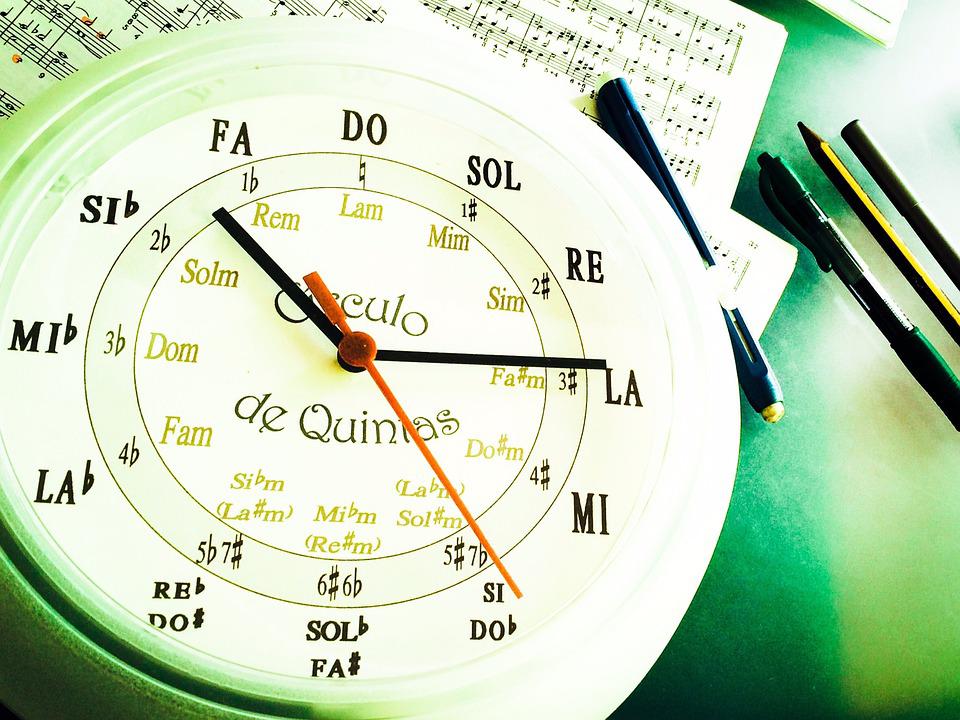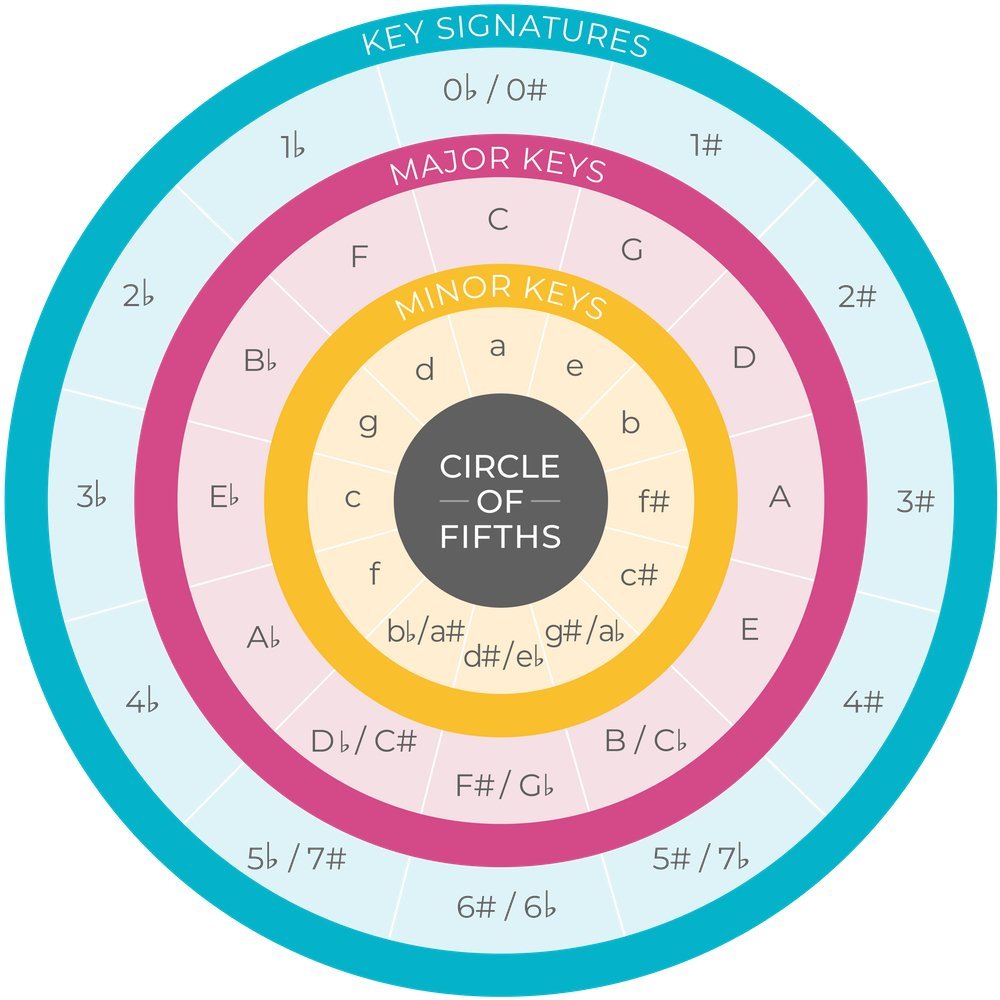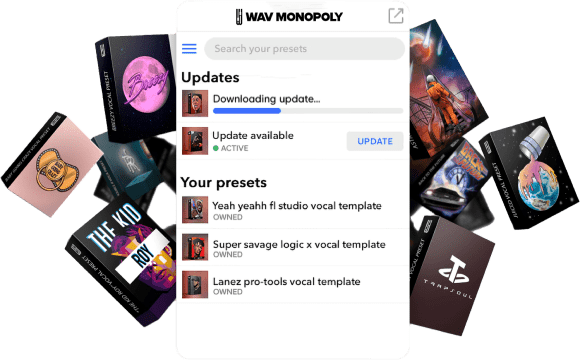LEARN MUSIC AND AUDIO PRODUCTION | Wavmonopoly TIPS AND TRICKS
Circle of Fifths: What It Is and How to Use It in Your Songwriting?

wavmonopoly July 12, 2022

Most musicians are familiar with the circle of fifths, but not everyone knows how to use it in their songwriting. In this blog post, we will discuss what the circle of fifths is and how you can use it to improve your songwriting skills. We will also provide some examples of songs that use the circle of fifths. So, if you’re curious about this musical tool and want to learn more, keep reading!
What is a circle of fifths in music?
The circle of fifths is a musical tool that can be used to understand the relationships between chords and keys.
It is also a helpful tool for songwriters, as it can be used to create interesting chord progressions.
The circle of fifths is based on the principle that there are 12 notes in music, which are arranged in a particular order: C, G, D, A, E, B, F sharp/Gb, C sharp/Db, G sharp/Ab, D sharp/Eb, A sharp/Bb, and F. This order is known as the chromatic scale.
If you were to start on note C and move up to the next note in the chromatic scale (G), you would have moved up a fifth.
This is why it’s called the circle of fifths – because it visualizes the relationship between notes that are a fifth apart.
You can see how this works in the image below:
The circle of fifths can be used to find the key of a song, as well as to create new chord progressions.
To do this, simply start on any note and move clockwise around the circle. For example, if you start on C, the next chord would be G (a fifth above C), followed by D, A, E, and so on.
You can also use the circle of fifths to create interesting chord progressions by starting on any chord and moving counterclockwise around the circle.
For example, if you start on C, the next chord would be F (a fifth below C), followed by Bb, Eb, and so on.
What can you see in the circle?
If you look at the circle of fifths, you’ll notice that some notes are closer together than others. For example, C and G are only a fifth apart, while C and F are a fourth apart.
This is because some notes have a lot of sharps or flats, while others have none. The further away two notes are on the circle, the more sharps or flats they have.
So how can you use the circle of fifths in your songwriting?

There are a few different ways that you can use the circle of fifths in your songwriting.
First, if you know the key signature of a song, you can use the circle of fifths to find the key of the song.
To do this, simply find the note that corresponds to the key signature and then move clockwise around the circle until you reach C.
For example, if a song has a key signature of two sharps, you would find F# on the circle of fifths and then move clockwise to C, which is the key of the song.
You can also use the circle of fifths to transpose a song into a different key.
To do this, find the note that corresponds to the original key signature and then move counterclockwise around the circle until you reach the desired key.
For example, if you wanted to transpose a song from C to G, you would find C on the circle of fifths and then move counterclockwise to G.
Finally, you can use the circle of fifths to create interesting chord progressions.
To do this, simply find the note that corresponds to the key signature and then move around the circle to find other interesting chords.
For example, if a song is in the key of C, you could create a chord progression by starting on C and then moving to D, F, G, and back to C.
This progression would be called a “circle of fifths” progression.
How can you use a key signature in the circle of fifths?
The circle of fifths is a great tool for understanding key signatures and how they work.
By starting on the root note of a key signature and moving clockwise around the circle, you can find the next note in the scale.
This can be very helpful when trying to figure out what key a piece of music is in.
Additionally, by understanding the relationships between key signatures, you can more easily transpose music into different major and minor keys.
Why is the order of sharps and flats important?
The order of sharps and flats is important because it determines the key signature of a song.
The key signature is a set of notes that are used to identify the key of a song. If the key signature has two sharps, for example, then the song is in the key of D.
If the order of sharps and flats were different, then the key signature would be different, and the song would be in a different key.
Therefore, the order of sharps and flats is an important part of understanding how music works.
How to memorize the order of flats and sharps?
There are a few different ways that you can remember the order of sharps and flats. One way is to memorize the mnemonic “Fats Cats Eat A Lot Of Green Food.”
This mnemonic helps you remember that the order of sharps is F, C, G, D, A, E, B.
Another way to remember the order of sharps and flats is to memorize the major key signatures.
The major key signatures go in this order: C, G, D, A, E, B, F#/Gb, C#/Db, Ab, Eb, Bb, F.
By memorizing these key signatures, you will be able to remember the order of sharps and flats.
Finally, you can also use a chart to help you remember the order of sharps and flats. There are many different charts available online or in music theory books.
By using one of these charts, you will be able to easily see the order of sharps and flats and how they relate to each other.
By using these tips. you can remember how many sharps any key has and the exact order of it.
Circle of Fifths: What’s in the middle?
Note C is in the middle of the circle of fifths. This is because C is the root note of the major scale, which is the most important scale in music.
The other notes in the major scale are located around the circle of fifths in order. For example, G major is located to the right of C, and D is located to the left of C.
By understanding the relationships between these notes, you can more easily understand how music works.
How can you memorize the Circle of Fifths?
There are a few different ways that you can memorize the circle of fifths. One way is to use a mnemonic device, such as “Every Good Boy Deserves Fudge.”
This mnemonic can help you remember the order of the notes in the scale: E, G, B, D, and F.
Another way to memorize the circle of fifths is to practice writing out the scale in order.
This will help you familiarize yourself with the order of the notes and their relationships to one another.
Finally, you can also try using flashcards to memorize the order of the notes in the scale.
Whatever method you choose, make sure that you practice regularly so that you can commit the information to memory.
How the Circle of Fifths has been used in popular music
The Circle of Fifths has been used in popular music for centuries, and it is still used today by many artists.
Many popular songs have made use of the circle of fifths, and it is a tool that every musician should understand. Some of these songs are:
1. “The Weight” by The Band
2. “You’ve Got a Friend” by James Taylor
3. “I Will Always Love You” by Whitney Houston
4. “Yesterday” by The Beatles
5. “Somewhere Over the Rainbow” by Judy Garland
6. “A Whole New World” from Aladdin
7. “Beauty and the Beast” from Beauty and the Beast
8. “Can’t Help Falling in Love” by Elvis Presley
9. “My Heart Will Go On” from Titanic
10. “Hallelujah” by Leonard Cohen
The benefits of using the Circle of Fifths in songwriting
The Circle of Fifths is a powerful tool that can help you write better songs. It can help you create catchy melodies, many chord progressions, and countermelodies.
By understanding how to use the Circle of Fifths, you can take your songwriting to the next level.
One of the best things about the Circle of Fifths is that it’s a visual representation of music theory.
This means that it’s easy to understand and use, even if you’re not a music theory expert.
The Circle of Fifths helps you understand key signatures and the diatonic chords. It also shows how these relationships can be used to create interesting chord progressions.
If you’re new to songwriting, or if you’re looking for a way to improve your songwriting skills, the Circle of Fifths is a great place to start.
By understanding how to use the Circle of Fifths, you can write better songs that are more interesting and enjoyable to listen to.
Tips for using the Circle of Fifths in your own songwriting practice.
When you’re stuck on what chord to use next in your progression, or which melody note will sound best, the Circle of Fifths can be a helpful tool.
Here are some tips for using the Circle of Fifths in your songwriting practice:
-Start by identifying the key you’re working in. This will be the starting point on the circle.
-From there, move clockwise or counterclockwise around the circle to find chords that are in the same key as your starting point. These will usually sound good together.
-You can also use the Circle of Fifths to help you transpose a song into a different key. Just find the key you want to transpose to on the circle and then find the chords that are in that key.
-The Circle of Fifths can also be a helpful tool for writing melodic lines. Just find the starting note on the circle and then move up or down to find other notes that will sound good with it.
By using the Circle of Fifths in your songwriting practice, you’ll be able to write better progressions and create more interesting melodies. Give it a try and see what you can come up with!
Final Thoughts
The circle of fifths is a powerful tool that can help you understand chords and keys. By understanding how the circle works, you can use it to create songs in any key signature. You also gain a deeper understanding of music theory and how different harmonic structures work together. We hope this article has helped you see the power of the Circle of Fifths and given you some ideas on how to use it in your own songwriting. How have you used the Circle of Fifths in your own music?
Frequently Asked Questions:
What is the relative minor key?
The relative minor key is the minor key that has the same key signature as the major key.
For example, if you’re in the key of C major, the relative minor key is A minor.
What is the relative major key?
The relative major key is the major key that has the same key signature as the minor key.
For example, if you’re in the key of A minor, the relative major key is C major. You can use the same method for adjacent keys.
How can you use major keys and minor keys in your songwriting?
One way to use major and relative minor keys in your songwriting is to write a song in a major key and then transpose it into a minor key.
This can give your song a different feel and add an element of suspense or tension. You can also use the Circle of Fifths to find chords that are in the same key as your starting point.
This can help you create interesting chord progressions and write better melodies.
Another way to use minor and relative minor keys in your songwriting is to write a song in a minor key and then transpose it into a major key.
This can give your song a different feel and add an element of excitement or joy. You can also use the Circle of Fifths to find chords that are in the same key as your starting point.
This can help you create interesting chord progressions and write better melodies.
Finally, you can use the Circle of Fifths to help you transpose a song into a different key.
This can be a helpful tool if you’re stuck on what chord to use next in your progression, or if you’re looking for a way to change up your sound.
Just find the key you want to transpose to on the circle and then find the chords that are in that key.
This will give you a new starting point for your progression and help you create a more interesting melody.
What are some other things I should know about the circle of fifths?
There are a few other things that are worth knowing about the circle of fifths. First, it is important to note that the circle of fifths only goes up in perfect fifth intervals.
This means that if you start on any note on the circle and move clockwise by seven notes, you will not end up at the note that is a perfect fifth higher than your starting note. For example, if you start on C and move clockwise seven notes, you will end up on B, which is a major second above C.
Additionally, the circle of fifths can be used to find the key of a song if you know the chords that are being used. For instance, if you know that a song is using the chords C, G, and D, you can start on C and move clockwise two spaces to find that the song is in the key of G.
Finally, it is worth mentioning that there are variations of the circle of fifths that go up in fourths or down in fifths. However, these variations are not as commonly used as the standard circle of fifths.
